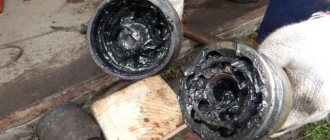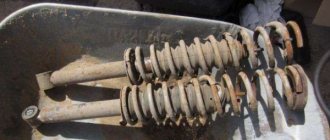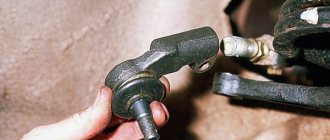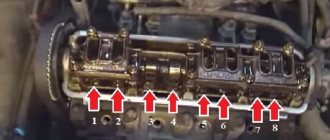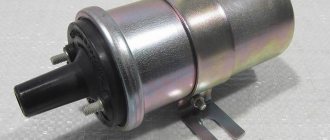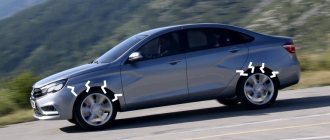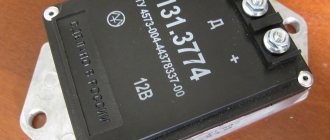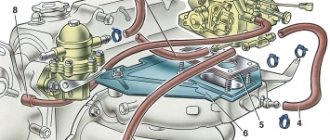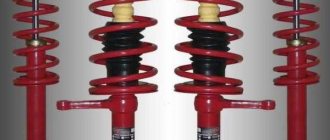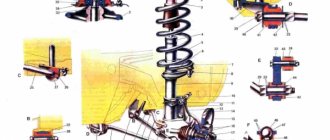Self-identification of causes
VAZ 2110 knocking when turning
If you go to a service station or VAZ car service center, you should not expect that the cause will be discovered. For this reason it is recommended:
- First, rinse the entire front suspension with running water:
- wait until it dries or at least flows around;
- drive into a garage with an inspection hole;
- clean with a brush all places of twists and connections;
- thoroughly visually inspect the entire front suspension.
Note. This needs to be done because there can be many reasons.
VAZ 2110 creaks when turning the steering wheel
You should start by inspecting all load-bearing working connections:
- Check the tightness of the stabilizer bolts to the body.
- Inspect the rubber cushions of the strut support; they may fall apart or sag.
- Check the fastening of the suspension, try to stretch it.
- Check the brace, suspension strut, silent blocks of the lever, and suspension system.
- Also check the fastenings of the brace, barbell, and rubber pads.
- Check the compression stroke buffer for damage, it can also cause knocking.
- Check the wear of the lower arm, the hinge of the suspension arm.
In addition, you need to feel the coils of the suspension spring with your hands. When it settles, deforms or the spirals break, this can cause a dull knock. A knocking sound when driving a car can be detected without much professional experience. Before starting repair work, you must carefully and painstakingly study the design of the front end suspension system. The knocking noise can be caused by the plastic wheel arch protection. It turns around and, when turning, clings to the boot of the grenade. You can temporarily spray the stabilizer bushings with silicone grease. But this is temporary, not long-term protection. The rubber compresses the stabilizer rod; if it gets wet, it will still creak. Therefore, you need to prepare a set of rubber, do not tighten it, and change them.
Design features of the front suspension system
VAZ 2110 crunching when turning
This system is the most important part of a front-wheel drive vehicle. It consists of telescopic hydraulic shock absorber struts, coil springs, lower wishbones with braces, and a stabilizer bar. The structural part is a shock absorber strut. Its bottom is connected to the steering knuckle with 2 bolts. The strut bracket has a hole at the top through which it is bolted to the body. The bolt has an eccentric collar and an eccentric washer. This bolt is used to adjust the wheel alignment of the drive hubs. The following structural parts are mounted on the telescopic stand:
- spring;
- polyurethane foam compression stroke buffer;
- upper strut support assembly with bearing.
Strengthening the support cup of the VAZ 2110 strut
With such wear on the cup, even a new strut will knock.
Theoretically, even a new strut can knock if the hole for the shock absorber rod in the support cup is worn out. This occurs due to corrosion, improper installation of the strut, poor quality bushings and dampers. The problem can be solved by placing two washers with an internal diameter of 14 mm on both sides (top and bottom).
It is advisable to boil the washers if the glass is not very rusty. This size is dictated by the fact that the diameter of the stock rear shock absorber rod of the VAZ 2110 is 10 mm, and the diameter of the spacer sleeve is 14 mm
It is important to control the length of the thread, since when installing thick washers it may not be enough. In this case, shorten the spacer to the thickness of both washers
After this modification, in most cases the knocking of the strut disappears.
CV joints are the main instigators of knocking noises during rotation
Often problems are solved by replacing CV joints. This is a rotary mechanism in the external version and an object of independent transmission of torque in the internal version. If before the mystical knocking sound appeared when turning, you did not hear crunching sounds, then the internal CV joint may be to blame. The outer one fails more often, but before failure it begins to crunch when turning. You can check the part as follows:
- put the car in the pit, turn off the speed and turn on the handbrake for easy access to the axle shafts and other suspension elements in the front of the car;
- check for play on the axle shafts by loosening them from top to bottom or in different directions, then check the play by pushing the axle shaft inside the CV joint and back;
- if there is play, the parts have fallen apart, they need to be replaced, you should buy only high-quality spare parts to carry out the necessary repair processes;
- Before replacing, do not forget to drain the oil from the gearbox, since otherwise it will simply flow out through the holes that appear at the site where the CV joints are installed.
The process of replacing internal CV joints is quite complicated. Interestingly, the main reason for parts failure is a torn boot. A part that costs a hundred rubles damages an expensive mechanism that is very difficult to replace. So it is worth monitoring the condition of the anthers and always changing them if necessary.
The brakes are also knocking
Many budget car brands suffer from a thud in the suspension that is not related to the chassis when driving over uneven surfaces. "Renault Duster" also applies to them. The reason often lies in the poor quality of the brake pads. The good thing is that this is extremely easy to check. It’s enough to drive out onto paving stones or similar surfaces, open the window and listen. If the sound disappears when you press the brake pedal, then the problem is definitely in the pads. In this case, they simply need to be replaced with better ones, preferably original ones; it is also recommended to check the condition of the bracket, which becomes less elastic over time. True, it is worth noting that the nature of the knock in this case is rather not dull, but, on the contrary, loud.
Ball joint - knocking in the suspension of different characters
There is a part in the car suspension that is difficult to check. If it knocks, it happens precisely on small and unnoticeable irregularities. The ball loses its lubricant and begins to move very difficultly inside the seat. This causes sounds like creaking, light knocking, and annoying rattling. An element fails for the following reasons:
- just natural wear of the part, which occurs every 100,000 kilometers; during operation, the mechanism wears out, lubricant comes out, and efficiency decreases;
- the support begins to knock quite unexpectedly, the intensity of the sounds quickly increases, so it is better to promptly replace the element;
- when installing a low-quality support, a not very pleasant process occurs - after a few thousand kilometers, extraneous sounds appear that are unpleasant to listen to;
- Also, a torn boot is one of the main causes of problems in this part of the car, so you should constantly look at the rubber bands and their integrity.
The ball joint is very difficult to diagnose. To check it, it must be removed, which cannot be done without the help of a professional service. That is why they often do not sin on it when going through other suspension parts. It may well happen that you change half of the suspension until you get to the knock directly in the ball joint.
General information
The very appearance of unnecessary sounds in the operation of the car’s suspension signals a particular malfunction. The silent blocks may have broken or the ball joints may have play. Of course, there is no need to guess here; it is advisable to take the car for diagnostics, where specialists will render a verdict. But you can do this yourself. True, you will need a hole in the garage for visual inspection and troubleshooting.
There can be a huge number of reasons. Moreover, it is not always a matter of suspension. There may be wear on the steering rack, brake system, etc. But all this can only be determined by inspection. But let's start from the very beginning and figure out why, in fact, knocking occurs in the suspension when driving over uneven surfaces.
Struts and strut supports are a problem for every car
Even high-quality and reliable racks begin to struggle with unevenness and knock after prolonged use. For a Chinese spare part, a long service life of 1000 kilometers is considered, for an original Japanese or European one - 15-20 thousand. Struts and upper supports regularly fail on cars in Russia, and the reasons for this can be very different:
- the strut itself rarely fails completely; when the car is rocking, creaking and extraneous sounds will be heard, and the knock will be heard throughout the entire suspension at once;
- the support in most cases fails at the moment when the support bearing breaks, this happens in the event of a sudden collision with large uneven roads;
- Perhaps a simple tightening of the support or shock absorber fastening at the top point will help you; you need to check all fastening elements;
- If the struts break down, they may leak, which will be visible on the body, but this is not a prerequisite, but simply a recommendation for additional diagnostics of the suspension element.
It is better to install only high-quality parts of the chassis. We are talking about original or European spare parts. Many motorists use Japanese KYB parts and buy quite adequate Monroe struts. The supports must be installed using original ones, despite their high cost. This is the only chance to get the necessary aspects of operation.
Types of bearings
There are two design versions of the upper part of the rack:
- The support bearing is included in the support design (can be found on a number of VAZ models);
- It is a separate element that is placed between the support and the upper spring cup.
But there are several support bearings themselves that are used in the suspension design:
- WITH BUILT-IN OUTER OR INNER RING. Its peculiarity lies in the possibility of rotation of elements that are in contact with both the outer and inner rings. Additionally, this option provides installation holes, so no pressure flanges are needed during installation;
- WITH DETACHABLE OUTER OR INNER RING. In this embodiment, one of the rings (depending on the design) can be separated, while the second is fixed to the support;
- SINGLE-SPLIT. Structurally, this option is the same bearing with a detachable ring, but has increased rigidity.
In general, there is no particular difference which type of bearing is used, the main thing is that it performs its functions.
Despite the fact that the upper part of the strut is installed inside a special niche in the wheel arch, dirt, sand and dust penetrate the support, and these contaminants are destructive to any bearing.
Additionally, the support bearing is almost constantly subjected to rapidly changing loads, including shock loads (due to the operation of the spring), which, in combination with contamination, leads to intense wear of the bearing components and its failure.
Due to rather difficult operating conditions, the service life of such a bearing is limited. Many manufacturers indicate that it must be replaced every 100 thousand km.
But in reality, due to the poor condition of the roads, they require replacement after 50 thousand km. At the same time, the resource of this node also depends on its quality.
It is not uncommon for a support bearing to be replaced after 10,000 km.
The steering rack is a quiet, separate element with sophisticated diagnostics
It often happens that after reassembling the entire chassis, it is time to check the steering rack. By moving the steering wheel left and right, you will hear small knocks if the rack has already begun to wear out. But this does not mean at all that it knocks during operation. It is difficult to give general recommendations here; there are different recommendations for owners of different cars:
- It’s worth visiting specialized forums and reading information about how and when the steering rack fails, how you can check and fix it;
- tightening the steering rack is a solution for a few days; soon it will start knocking again if a problem is identified with this particular element of the car;
- the knock of the rack is often a distinct feedback on the steering wheel, as well as on the body in the area where the control pedals are attached, so diagnosis will not be difficult;
- Sometimes steering tips or rods knock, which is more difficult to check, but you can perform a full diagnosis in a pit without any problems or inaccuracies.
The steering system likes to knock in domestic cars, as well as in cars older than 10 years. Changing the steering rack is very difficult due to the high cost of spare parts and the rather inconvenient location in many cars. Therefore, they prefer to perform this process on a service. Professionals will complete all tasks quite simply and quickly.
Product delivery options
Note! Below are the shipping methods available specifically for this product. Payment options may vary depending on the delivery method.
Detailed information can be found on the “Delivery and Payment” page.
Parcel by Russian Post
Available payment methods:
Cash on delivery (payment upon receipt)
Using cards Sberbank, VTB, Post Bank, Tinkoff Yandex.Money QIWI ROBOKASSA
Shipping throughout Russia. Delivery time is from 5 to 12 days.
Parcel by Russian Post 1st class
Available payment methods:
- Cash on delivery (payment upon receipt)
- Using cards Sberbank, VTB, Post Bank, Tinkoff
- Yandex money
- QIWI
- ROBOKASSA
Shipping throughout Russia. Delivery time is from 2 to 5 days. More expensive than regular delivery by Russian Post, approximately 50%. Parcel weight up to 2.5 kg
Express Parcel EMS
Available payment methods:
- Cash on delivery (payment upon receipt)
- Using cards Sberbank, VTB, Post Bank, Tinkoff
- Yandex money
- QIWI
- ROBOKASSA
Shipping throughout Russia. Delivery time is from 3 to 7 days. More expensive than regular delivery by Russian Post, approximately 100%.
Transport companies
Available payment methods:
- Using cards Sberbank, VTB, Post Bank, Tinkoff
- Yandex money
- QIWI
- ROBOKASSA
Delivery is possible to any locality where there is a representative office of the transport company. Delivery time is from 2 to 10 days. Sending large parcels is approximately 50% more profitable than by Russian Post.
Silent blocks in the front of the car - replacement check
A very important element of the front suspension, which can knock in the most unusual way, is a set of silent blocks. The most common knocking sounds are the rear silent blocks of the front suspension arms, as well as the support silent blocks of the stabilizer, which are attached to the body. The whole problem is solved by replacement, there is no point in diagnosing for a long time - it is better to change the part. Failure occurs for the following reasons:
- the rubber simply breaks due to increased loads, it does not withstand too much pressure and is deformed under the influence of the connections of the suspension arms;
- The silent block stops turning freely in the right place, there is no flexibility in the suspension, and the levers knock due to the lack of the required maneuver;
- the rubber has worn through, worn out and decreased in size, so metallic sounds are heard from the chassis, which are difficult to diagnose;
- It is necessary to pay attention to the fastenings of silent blocks; often replacing them turns out to be difficult due to preliminary unskilled work with suspension parts.
You can check while driving whether the rear silent blocks of the front control arms are knocking. You need to place your foot directly on the floor and listen to whether there is a knock on your foot. The same procedure should be done on the passenger seat. The stabilizer support bushings are checked by placing your foot or hand on the part of the body behind the pedals. However, if you have suspicions, you can simply change this element. We invite you to watch a short video with self-diagnosis of the Hyundai Solaris suspension:
What indicates a malfunction?
Motorists notice a problem when they hear a knocking sound in the front suspension. It is not yet a signal that it is necessary to contact a car service, except in cases where parts have begun to break down, and even a beginner can determine this. The driver should learn to distinguish which sounds are completely natural and which indicate a breakdown.
It may be time to walk away from this car. Of course, some noises that come from under the car have nothing to do with the suspension or steering systems, but this can be difficult to determine. For example, take the exhaust system - muffler, pipe and tailpipe, and catalytic converter. If everything is not on the right side or the hangers are loose or broken, it is possible that there will be accidental contact between them and the body or drive belt, as well as the associated lever.
Try forcing the system from outside to see if you can duplicate the sound. A broken motor mount can cause severe shock. Soaking the oil could have caused it to delaminate, or perhaps a couple of bolts were loose. This condition will be sensitive to the throttle being turned on or off, but will not be detected by the bumps.
When you hear a knock in the front suspension, you should not immediately panic. This unit is quite reliable and strong. It will take a long time or strong mechanical impact before it completely fails.
Let's sum it up
It is worth using various methods to test equipment before replacing. Otherwise, because of one knock, you can change half of the suspension without eliminating the cause of the problem. Therefore, you should always approach diagnostics from different angles and use the services of testing suspension parts at several service stations. You can change parts only if you are sure that certain mechanisms are faulty. You should approach the issue of repair with full understanding so as not to spend too much money on this process. Many novice drivers simply buy every part that they are guilty of, and as a result, repairs are very expensive.
There are certain difficulties in diagnosing the chassis of a modern car. It is not at all clear which element may be causing the knocking. There are a number of possible options, they are all interconnected, and even analysis does not answer the question. Therefore, it is very difficult to use the full picture of the breakdown to purchase the spare parts necessary for repair. Sometimes you have to change parts just at random, not getting the result on the first try. There are various repair options available, but to do so you need to pinpoint the problem. How do you usually diagnose and repair the chassis of your car?
Serious faults
Car drivers often encounter wear on the rubber-metal ball joints in their levers. They can be inspected by turning the steering wheel. If there are cracks in the top layer of rubber, parts should be replaced. It is worth noting that a knocking sound in the front suspension of a VAZ or any other car may indicate the presence of a large gap in the wheel bearings or their malfunction. To set the gap, you cannot do without contacting a car service, since you will need the work of an experienced craftsman and the use of a lift.
A fairly common cause of knocking while driving is improper wheel balancing or deformation of their discs. In case of significant damage to parts, it is advisable to completely replace them. Repairs are only necessary in cases where the discs only have cracks or minor dents.
The cause of knocking in the front suspension may be sagging springs. This also occurs when the undercarriage bounces due to weak tightening of the lever fasteners or destruction of the compression buffers. The motorist should check whether the levers, body side members and steering knuckles are deformed. In order to carry out high-quality repairs, if you notice a knock in the front suspension of a Ford or other cars, you should contact specialized centers for diagnostics and further troubleshooting.
